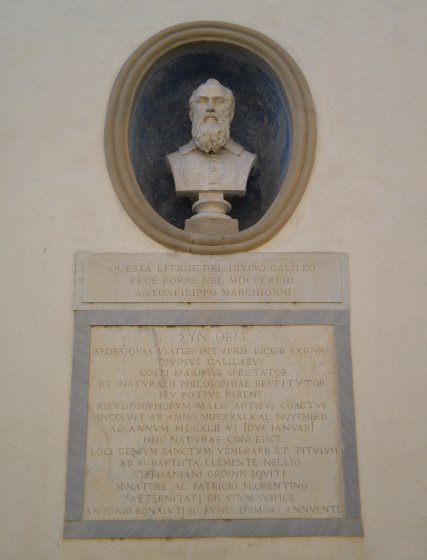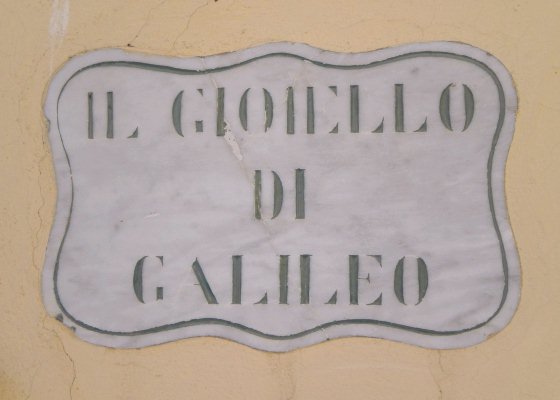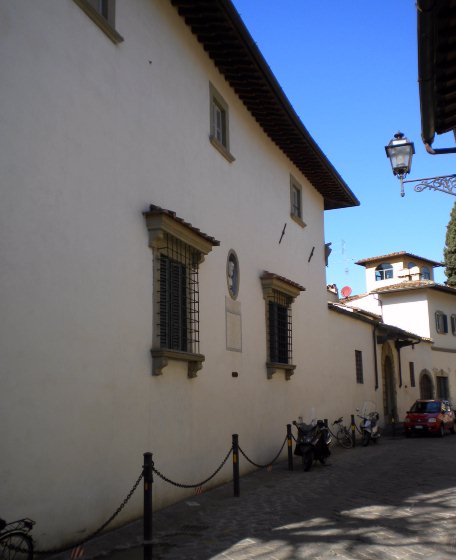

![]() Die Villa, in der
Galileo
Galilei
seinen Hausarrest verbüßte, befindet sich in dem kleinen Vorort von Florenz
namens Arcetri. Um zu dieser Villa zu gelangen folgt man am besten von der
Villa Giovanelli, diese links liegen lassend, der Straße
Via della Torre del Gallo nach Süden. Diese stößt dann nahe dem
Observatorium auf die Straße Via del Pian dei Giullari, in die man
links einbiegt und ihr weiter gen Süden bis zur
Villa Il
Gioiello folgt1).
Die Villa, in der
Galileo
Galilei
seinen Hausarrest verbüßte, befindet sich in dem kleinen Vorort von Florenz
namens Arcetri. Um zu dieser Villa zu gelangen folgt man am besten von der
Villa Giovanelli, diese links liegen lassend, der Straße
Via della Torre del Gallo nach Süden. Diese stößt dann nahe dem
Observatorium auf die Straße Via del Pian dei Giullari, in die man
links einbiegt und ihr weiter gen Süden bis zur
Villa Il
Gioiello folgt1).
An der Stirnseite des Gebäudes (siehe das Bild am Ende dieser Seite) fällt in einer Nische eine Büste von G. Galilei auf. Darunter befinden sich zwei Schrifttafeln, eine in italienischer und darunter eine größere in lateinischer Sprache. Letztere enthält auch zwei Worte in griechischen Schriftzeichen.
Der Text der oberen Inschrift bezieht sich auf die Büste und lässt sich wie folgt übersetzen:
| Dieses Bildnis des göttlichen Galileo ließ Antonfilippo Marchionni im Jahr 1843 aufstellen. |
Die umfangreiche untere Inschrift beschreibt mit blumigen Worten die Umstände der letzten Lebensjahre G. Galileis und kann wie nachstehend ins Deutsche übersetzt werden:
| So Gott will Reisender, Du siehst diesen, freilich kleinen, Tempel. Galileo, der große, göttliche Beobachter des Himmels und Erneuerer der Naturwissenschaft oder eher Vater der falschen Lehre; angetrieben durch die schlechten Eigenschaften hat er sich verstrickt, von November 1631 bis 6. Januar 1642 ist er vor der Natur zurückgewichen. Verehrt den heiligen Geist des Ortes und die Inschrift von Ioannis Baptista Clemente Nellio, Ritter des Stephansordens, Senator und vornehmer Bürger von Florenz. Blicke auf das Geweihte für die Ewigkeit. [Angebracht] mit Zustimmung durch Antonio Bonaiuti, dem Herrn des Anwesens. |
Dabei ist anzumerken, dass erst zu Lebzeiten von Giovanni Baptista Clemente de Nelli2) (1725 - 1793) der Bann der Kirche auf Schriften, die ein heliozentrisches Weltbild vertraten, aufgehoben wurde. Demzufolge sollten die Formulierungen der Inschrift sicher nicht den Zorn der Kirche heraufbeschwören. Deshalb kann man davon ausgehen, dass hier die "falsche Lehre" für das heliozentrische System steht, für das sich G. Galilei eingesetzt hat. Auf die Umschreibung von "Hausarrest" durch aktives(!) vor der Natur zurückweichen muss man auch erst einmal kommen.
Verschiedentlich findet man noch weitere kleinere Beschriftungen wie VILLA GALILEO und IL GIOIELLO DI GALILEO vor; letzteres bedeutet ins Deutsche übersetzt: "Der Juwel des Galileo", wobei zu beachten ist, dass Il Gioiello auch der Name des Anwesens ist.
Die Fotos wurden im Februar 2011 aufgenommen. Die Übersetzung der lateinischen Inschrift hat Anica Jahning aus Berlin vorgenommen.
1) Das eigentliche Problem stellt sich wie folgt dar. Der Ort Arcetri ist auf den zu erwerbenden Stadtplänen von Florenz in der Regel nicht verzeichnet. Deshalb wird hier diese Wegbeschreibung angegeben. (Zurück zum Bezug)
2) Siehe auch die Ausführungen zu Galileo Galileis Grabstätte. (Zurück zum Bezug)

![]() The villa in which
Galileo
Galilei
lived while staying under house arrest is located in Arcetri, a suburb of Florence.
For approaching this villa it is best to start from the
Villa Giovanelli, leaving it on the left and to follow the
street Via della Torre del Gallo to the south. Near the observatory one reachs the
street Via del Pian dei Giullari and follows it on the left furthermore to the south
until the Villa
Il Gioiello1).
The villa in which
Galileo
Galilei
lived while staying under house arrest is located in Arcetri, a suburb of Florence.
For approaching this villa it is best to start from the
Villa Giovanelli, leaving it on the left and to follow the
street Via della Torre del Gallo to the south. Near the observatory one reachs the
street Via del Pian dei Giullari and follows it on the left furthermore to the south
until the Villa
Il Gioiello1).
At the frontside of this building (see the most upper picture) there is a bust of G. Galilei in a niche. Below are to plaques with inscriptions. One in Italic and a larger one in Latin with two words Greek.
The inscription of the first mentioned plaque is related to the bust and reads like:
| This bust of the Divine Galileo was placed in 1843 by Antonfilippo Marchionni |
The extensive inscription of the lower plaque describes the circumstances of G. Galilei last years with strange looking words.
| So God will, traveler, you look on the tiny temple. Galileo, the great, divine observer of the sky and restorer of natural philosophy, or rather father of the false science; driven by bad behavior he got entangled. From November 1631 until January 6th, 1642 he receded from nature. Admire the holy spirit of the location and the inscription of Ioannis Baptista Clemente Nellio knight of the Order of Saint Stephen, senator and noble citizen of Florence. Look on the sacred for the eternity. [Attached] with consent by Antonio Bonaiuti, the master of the estate. |
It should be mentioned that the ban against works concerned with the heliocentric system was lifted during the lifetime of Giovanni Baptista Clemente de Nelli2). Hence the text must be chosen not to provoke the anger of the clergy. It appears common that the idiom "false science" means the heliocentric system favoured by G. Galilei. On the other hand it looks like that to actively recede from nature means to be placed under house arrest!
There are some small plaques containing texts like VILLA GALILEO and IL GIOIELLO DI GALILEO. The latter means "The jewel of Galileo" but one must remind that the estate is named Il Gioello.
The photographs were taken in February 2011.
1) The suburb Arcetri is usually not contained on city maps. This fact is the reason why it is explained how to approach the villa. (Back to the reference)
2) See also the explanations concerned with G. Galilei's burial place. (Back to the reference)

| Back to the main page | Created by Wolfgang Volk in March 2012 |